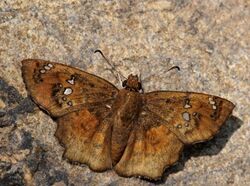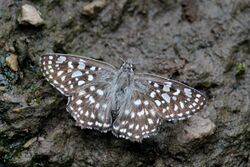Biology:Abaratha agama
From HandWiki
Short description: Species of butterfly
| Spotted angle | |
|---|---|

| |
| Dry-season form from Kerala | |

| |
| Wet-season form from Bangalore | |
| Scientific classification | |
| Domain: | Eukaryota |
| Kingdom: | Animalia |
| Phylum: | Arthropoda |
| Class: | Insecta |
| Order: | Lepidoptera |
| Family: | Hesperiidae |
| Genus: | Abaratha |
| Species: | A. agama
|
| Binomial name | |
| Abaratha agama (Moore, 1857)
| |
| Synonyms | |
|
List
| |
Abaratha agama, the spotted angle,[1] is a species of butterfly belonging to the family Hesperiidae. It is found from southern India[1] to Myanmar and in Thailand, Laos, Vietnam, southern China, Java and Sulawesi. The species was first described by Frederic Moore in 1857.[2][3][4][5][6][7]
Description
Male. Upperside dark blackish-grey covered with white spots. Forewing with four spots in the cell, commencing with a dot before the middle, a spot in the middle, another towards the end, constricted in its middle, with a dot above it and a lunule at the end, the last two having rows of spots below them, one in each interspace, except the interuo-median which has two in each row; three conjugated spots where the sub-apical spots usually are, with the two dots below them, a post-discal series of spots composed of eight spots, the four lower ones in a row a little inwards, the lower two small, and a sub-marginal row of small spots. Hindwing with a small spot in the middle of the cell, a lunule at the end, the latter the centre of a middle row of small spots, a post-discal and a sub-marginal row; the cilia of both wings black, with white spots opposite the sub-marginal spots. Underside. Forewing white, all but the lower basal portion suffused more or less with blackish-grey, the spots as above. Hindwing white, without suffusion, the spots round and black, one at the end of the cell, another above it below the costa, a twin spot below it, towards the base of the interno-median interspace, a discal row of spots, those in the middle smaller than the others, and a sub-marginal row of larger spots; marginal line of both wings black; palpi, body below and the legs white, the long tuft of hairs on the base of foreleg black; head and body above blackish-grey, a white spot on each side of the head. Antennae with a white streak on the club, and white dots on the shaft. Female similar to the male.
References
| Wikimedia Commons has media related to Abaratha agama. |
- ↑ 1.0 1.1 R.K., Varshney; Smetacek, Peter (2015). A Synoptic Catalogue of the Butterflies of India. New Delhi: Butterfly Research Centre, Bhimtal & Indinov Publishing, New Delhi. pp. 33. doi:10.13140/RG.2.1.3966.2164. ISBN 978-81-929826-4-9. https://www.researchgate.net/publication/287980260.
- ↑ "Caprona agama agama (Moore,[1858)"]. http://yutaka.it-n.jp/hes/90990001.html.
- ↑ Savela, Markku. "Caprona agama (Moore, [1858)"]. http://www.nic.funet.fi/pub/sci/bio/life/insecta/lepidoptera/ditrysia/hesperioidea/hesperiidae/pyrginae/caprona/#agama.
- ↑ Asiatic Society of Bengal (1832). "Journal of the Asiatic Society of Bengal". Journal of the Asiatic Society of Bengal 55 (1886): 138. https://archive.org/stream/journalofasiatic55unse#page/137/mode/1up.
- ↑ E. Y., Watson (1891). Hesperiidae Indicae: being a reprint of descriptions of the Hesperiidae of India, Burma, and Ceylon. Madras: Vest and Company. pp. 100. https://www.biodiversitylibrary.org/item/64080#page/114/mode/1up.
- ↑ W. H., Evans (1949). A Catalogue of the Hesperiidae from Europe, Asia, and Australia in the British Museum. London: British Museum (Natural History). Department of Entomology. pp. 161. https://www.biodiversitylibrary.org/item/187283#page/185/mode/1up.
- ↑
 This article incorporates text from a publication now in the public domain: Swinhoe, Charles (1912–1913). Lepidoptera Indica. Vol. X. London: Lovell Reeve and Co.. pp. 78–79. https://www.biodiversitylibrary.org/item/103495#page/92/mode/1up.
This article incorporates text from a publication now in the public domain: Swinhoe, Charles (1912–1913). Lepidoptera Indica. Vol. X. London: Lovell Reeve and Co.. pp. 78–79. https://www.biodiversitylibrary.org/item/103495#page/92/mode/1up.
Wikidata ☰ Q5036315 entry
 |

